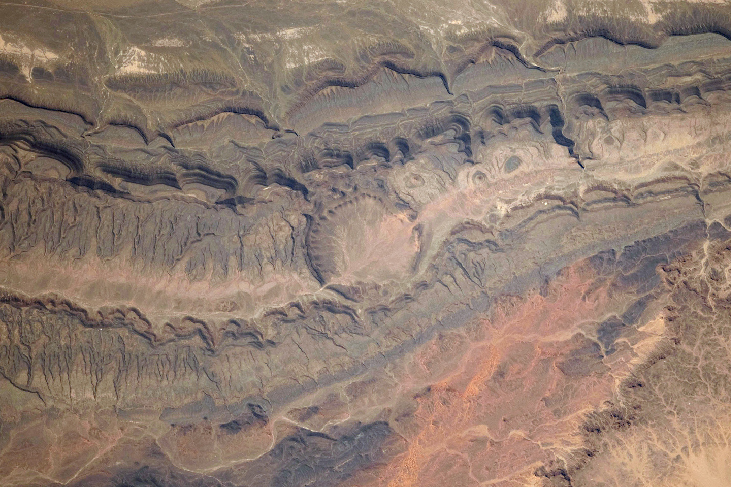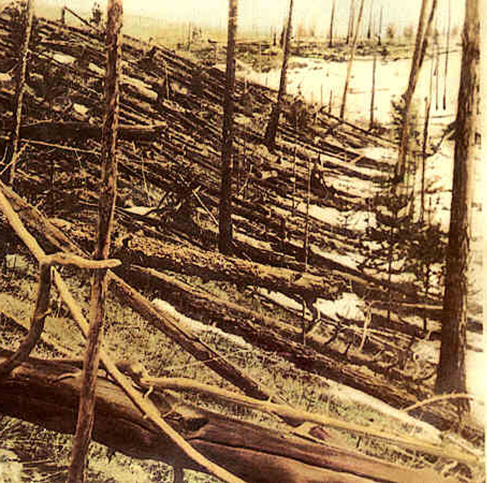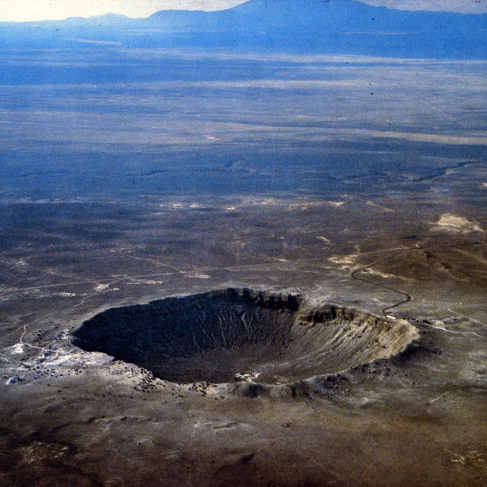Chapter 8 Earth as a Planet
8.5 Cosmic Influences on the Evolution of Earth
Learning Objectives
By the end of this section, you will be able to:
- Explain the scarcity of impact craters on Earth compared with other planets and moons
- Describe the evidence for recent impacts on Earth
- Detail how a massive impact changed the conditions for life on Earth, leading to the extinction of the dinosaurs
- Describe how impacts have influenced the evolution of life on Earth
- Discuss the search for objects that could potentially collide with our planet
In discussing Earth’s geology earlier in this chapter, we dealt only with the effects of internal forces, expressed through the processes of plate tectonics and volcanism. On the Moon, in contrast, we see primarily craters, produced by the impacts of interplanetary debris such as asteroids and comets. Why don’t we see more evidence on Earth of the kinds of impact craters that are so prominent on the Moon and other worlds?
Where Are the Craters on Earth?
It is not possible that Earth escaped being struck by the interplanetary debris that has pockmarked the Moon. From a cosmic perspective, the Moon is almost next door. Our atmosphere does make small pieces of cosmic debris burn up (which we see as meteors—commonly called shooting stars). But, the layers of our air provide no shield against the large impacts that form craters several kilometers in diameter and are common on the Moon.
In the course of its history, Earth must therefore have been impacted as heavily as the Moon. The difference is that, on Earth, these craters are destroyed by our active geology before they can accumulate. As plate tectonics constantly renews our crust, evidence of past cratering events is slowly erased. Only in the past few decades have geologists succeeded in identifying the eroded remnants of many impact craters ([link]). Even more recent is our realization that, over the history of Earth, these impacts have had an important influence on the evolution of life.

Recent Impacts
The collision of interplanetary debris with Earth is not a hypothetical idea. Evidence of relatively recent impacts can be found on our planet’s surface. One well-studied historic collision took place on June 30, 1908, near the Tunguska River in Siberia. In this desolate region, there was a remarkable explosion in the atmosphere about 8 kilometers above the surface. The shock wave flattened more than a thousand square kilometers of forest ([link]). Herds of reindeer and other animals were killed, and a man at a trading post 80 kilometers from the blast was thrown from his chair and knocked unconscious. The blast wave spread around the world, as recorded by instruments designed to measure changes in atmospheric pressure.

Despite this violence, no craters were formed by the Tunguska explosion. Shattered by atmospheric pressure, the stony projectile with a mass of approximately 10,000 tons disintegrated above our planet’s surface to create a blast equivalent to a 5-megaton nuclear bomb. Had it been smaller or more fragile, the impacting body would have dissipated its energy at high altitude and probably attracted no attention. Today, such high-altitude atmospheric explosions are monitored regularly by military surveillance systems.
If it had been larger or made of stronger material (such as metal), the Tunguska projectile would have penetrated all the way to the surface of Earth and exploded to form a crater. Instead, only the heat and shock of the atmospheric explosion reached the surface, but the devastation it left behind in Siberia bore witness to the power of such impacts. Imagine if the same rocky impactor had exploded over New York City in 1908; history books might today record it as one of the most deadly events in human history.
Tens of thousands of people witnessed directly the explosion of a smaller (20-meter) projectile over the Russian city of Chelyabinsk on an early winter morning in 2013. It exploded at a height of 21 kilometers in a burst of light brighter than the Sun, and the shockwave of the 0.5-megaton explosion broke tens of thousands of windows and sent hundreds of people to the hospital. Rock fragments (meteorites) were easily collected by people in the area after the blast because they landed on fresh snow.
The best-known recent crater on Earth was formed about 50,000 years ago in Arizona. The projectile in this case was a lump of iron about 40 meters in diameter. Now called Meteor Crater and a major tourist attraction on the way to the Grand Canyon, the crater is about a mile across and has all the features associated with similar-size lunar impact craters ([link]). Meteor Crater is one of the few impact features on Earth that remains relatively intact; some older craters are so eroded that only a trained eye can distinguish them. Nevertheless, more than 150 have been identified. (See the list of suggested online sites at the end of this chapter if you want to find out more about these other impact scars.)

Mass Extinction
The impact that produced Meteor Crater would have been dramatic indeed to any humans who witnessed it (from a safe distance) since the energy release was equivalent to a 10-megaton nuclear bomb. But such explosions are devastating only in their local areas; they have no global consequences. Much larger (and rarer) impacts, however, can disturb the ecological balance of the entire planet and thus influence the course of evolution.
The best-documented large impact took place 65 million years ago, at the end of what is now called the Cretaceous period of geological history. This time in the history of life on Earth was marked by a mass extinction, in which more than half of the species on our planet died out. There are a dozen or more mass extinctions in the geological record, but this particular event (nicknamed the “great dying”) has always intrigued paleontologists because it marks the end of the dinosaur age. For tens of millions of years these great creatures had flourished and dominated. Then, they suddenly disappeared (along with many other species), and thereafter mammals began the development and diversification that ultimately led to all of us.
The object that collided with Earth at the end of the Cretaceous period struck a shallow sea in what is now the Yucatán peninsula of Mexico. Its mass must have been more than a trillion tons, determined from study of a worldwide layer of sediment deposited from the dust cloud that enveloped the planet after its impact. First identified in 1979, this sediment layer is rich in the rare metal iridium and other elements that are relatively abundant in asteroids and comets, but exceedingly rare in Earth’s crust. Even though it was diluted by the material that the explosion excavated from the surface of Earth, this cosmic component can still be identified. In addition, this layer of sediment contains many minerals characteristic of the temperatures and pressures of a gigantic explosion.
The impact that led to the extinction of dinosaurs released energy equivalent to 5 billion Hiroshima-size nuclear bombs and excavated a crater 200 kilometers across and deep enough to penetrate through Earth’s crust. This large crater, named Chicxulub for a small town near its center, has subsequently been buried in sediment, but its outlines can still be identified ([link]). The explosion that created the Chicxulub crater lifted about 100 trillion tons of dust into the atmosphere. We can determine this amount by measuring the thickness of the sediment layer that formed when this dust settled to the surface.

Such a quantity of airborne material would have blocked sunlight completely, plunging Earth into a period of cold and darkness that lasted several months. Many plants dependent on sunlight would have died, leaving plant-eating animals without a food supply. Other worldwide effects included large-scale fires (started by the hot, flying debris from the explosion) that destroyed much of the planet’s forests and grasslands, and a long period in which rainwater around the globe was acidic. It was these environmental effects, rather than the explosion itself, that were responsible for the mass extinction, including the demise of the dinosaurs.
Impacts and the Evolution of Life
It is becoming clear that many—perhaps most—mass extinctions in Earth’s long history resulted from a variety of other causes, but in the case of the dinosaur killer, the cosmic impact certainly played a critical role and may have been the “final straw” in a series of climactic disturbances that resulted in the “great dying.”
A catastrophe for one group of living things, however, may create opportunities for another group. Following each mass extinction, there is a sudden evolutionary burst as new species develop to fill the ecological niches opened by the event. Sixty-five million years ago, our ancestors, the mammals, began to thrive when so many other species died out. We are the lucky beneficiaries of this process.
Impacts by comets and asteroids represent the only mechanisms we know of that could cause truly global catastrophes and seriously influence the evolution of life all over the planet. As paleontologist Stephen Jay Gould of Harvard noted, such a perspective changes fundamentally our view of biological evolution. The central issues for the survival of a species must now include more than just its success in competing with other species and adapting to slowly changing environments, as envisioned by Darwin’s idea of natural selection. Also required is an ability to survive random global catastrophes due to impacts.
Still earlier in its history, Earth was subject to even larger impacts from the leftover debris of planet formation. We know that the Moon was struck repeatedly by objects larger than 100 kilometers in diameter—1000 times more massive than the object that wiped out most terrestrial life 65 million years ago. Earth must have experienced similar large impacts during its first 700 million years of existence. Some of them were probably violent enough to strip the planet of most its atmosphere and to boil away its oceans. Such events would sterilize the planet, destroying any life that had begun. Life may have formed and been wiped out several times before our own microbial ancestors took hold sometime about 4 billion years ago.
The fact that the oldest surviving microbes on Earth are thermophiles (adapted to very high temperatures) can also be explained by such large impacts. An impact that was just a bit too small to sterilize the planet would still have destroyed anything that lived in what we consider “normal” environments, and only the creatures adapted to high temperatures would survive. Thus, the oldest surviving terrestrial lifeforms are probably the remnants of a sort of evolutionary bottleneck caused by repeated large impacts early in the planet’s history.
Impacts in Our Future?
The impacts by asteroids and comets that have had such a major influence on life are not necessarily a thing of the past. In the full scope of planetary history, 65 million years ago was just yesterday. Earth actually orbits the Sun within a sort of cosmic shooting gallery, and although major impacts are rare, they are by no means over. Humanity could suffer the same fate as the dinosaurs, or lose a city to the much more frequent impacts like the one over Tunguska, unless we figure out a way to predict the next big impact and to protect our planet. The fact that our solar system is home to some very large planets in outer orbits may be beneficial to us; the gravitational fields of those planets can be very effective at pulling in cosmic debris and shielding us from larger, more frequent impacts.
Beginning in the 1990s, a few astronomers began to analyze the cosmic impact hazard and to persuade the government to support a search for potentially hazardous asteroids. Several small but sophisticated wide-field telescopes are now used for this search, which is called the NASA Spaceguard Survey. Already we know that there are currently no asteroids on a collision course with Earth that are as big (10–15 kilometers) as the one that killed the dinosaurs. The Spaceguard Survey now concentrates on finding smaller potential impactors. By 2015, the search had netted more than 15,000 near-Earth-asteroids, including most of those larger than 1 kilometer. None of those discovered so far poses any danger to us. Of course, we cannot make a similar statement about the asteroids that have not yet been discovered, but these will be found and evaluated one by one for their potential hazard. These asteroid surveys are one of the few really life-and-death projects carried out by astronomers, with a potential to help to save our planet from future major impacts.
The Torino Impact Hazard Scale is a method for categorizing the impact hazard associated with near-Earth objects such as asteroids and comets. It is a communication tool for astronomers and the public to assess the seriousness of collision predictions by combining probability statistics and known kinetic damage potentials into a single threat value.
Purdue University’s “Impact: Earth” calculator lets you input the characteristics of an approaching asteroid to determine the effect of its impact on our planet.
Key Concepts and Summary
Earth, like the Moon and other planets, has been influenced by the impacts of cosmic debris, including such recent examples as Meteor Crater and the Tunguska explosion. Larger past impacts are implicated in some mass extinctions, including the large impact 65 million years ago at the end of the Cretaceous period that wiped out the dinosaurs and many other species. Today, astronomers are working to predict the next impact in advance, while other scientists are coming to grips with the effect of impacts on the evolution and diversity of life on Earth.
For Further Exploration
Articles
Earth
Collins, W., et al. “The Physical Science behind Climate Change.” Scientific American (August 2007): 64. Why scientists are now confident that human activities are changing our planet’s climate.
Glatzmaier, G., & Olson, P. “Probing the Geodynamo.” Scientific American (April 2005): 50. Experiments and modeling that tell us about the source and reversals of Earth’s magnetic field.
Gurnis, M. “Sculpting the Earth from Inside Out.” Scientific American (March 2001): 40. On motions that lift and lower the continents.
Hartmann, W. “Piecing Together Earth’s Early History.” Astronomy (June 1989): 24.
Jewitt, D., & Young, E. “Oceans from the Skies.” Scientific American (March 2015): 36. How did Earth get its water after its initial hot period?
Impacts
Boslaugh, M. “In Search of Death-Plunge Asteroids.” Astronomy (July 2015): 28. On existing and proposed programs to search for earth-crossing asteroids.
Brusatte, S. “What Killed the Dinosaurs?” Scientific American (December 2015): 54. The asteroid hit Earth at an already vulnerable time.
Chyba, C. “Death from the Sky: Tunguska.” Astronomy (December 1993): 38. Excellent review article.
Durda, D. “The Chelyabinsk Super-Meteor.” Sky & Telescope (June 2013): 24. A nice summary with photos and eyewitness reporting.
Gasperini, L., et al. “The Tunguska Mystery.” Scientific American (June 2008): 80. A more detailed exploration of the site of the 1908 impact over Siberia.
Kring, D. “Blast from the Past.” Astronomy (August 2006): 46. Six-page introduction to Arizona’s meteor crater.
Websites
Earth
Astronaut Photography of Earth from Space: http://earth.jsc.nasa.gov/. A site with many images and good information.
Exploration of the Earth’s Magnetosphere: http://phy6.org/Education/Intro.html. An educational website by Dr. Daniel Stern.
NASA Goddard: Earth from Space: Fifteen Amazing Things in 15 Years: https://www.nasa.gov/content/goddard/earth-from-space-15-amazing-things-in-15-years. Images and videos that reveal things about our planet and its atmosphere.
U.S. Geological Survey: Earthquake Information Center: http://earthquake.usgs.gov/learn/
Views of the Solar System: http://www.solarviews.com/eng/earth.htm. Overview of Earth.
Impacts
B612 Foundation : https://b612foundation.org/. Set up by several astronauts for research and education about the asteroid threat to Earth and to build a telescope in space to search for dangerous asteroids.
Lunar and Planetary Institute: Introduction to Terrestrial Impact Craters: http://www.lpi.usra.edu/publications/slidesets/craters/. Includes images.
Meteor Crater Tourist Site: http://meteorcrater.com/.
NASA/Jet Propulsion Lab Near Earth Object Program: http://neo.jpl.nasa.gov/neo/.
What Are Near-Earth-Objects: http://spaceguardcentre.com/what-are-neos/. From the British Spaceguard Centre.
Videos
Earth
All Alone in the Night: http://apod.nasa.gov/apod/ap120305.html. Flying over Earth at night (2:30).
Earth Globes Movies (including Earth at night): http://astro.uchicago.edu/cosmus/projects/earth/.
Earth: The Operator’s Manual: http://earththeoperatorsmanual.com/feature-video/earth-the-operators-manual. A National Science Foundation–sponsored miniseries on climate change and energy, with geologist Richard Alley (53:43).
PBS NOVA Videos about Earth: http://www.pbs.org/wgbh/nova/earth/. Programs and information about planet Earth. Click full episodes on the menu at left to be taken to a nice array of videos.
U. S. National Weather Service: http://earth.nullschool.net. Real Time Globe of Earth showing wind patterns which can be zoomed and moved to your preferred view.
Impacts
Chelyabinsk Meteor: Can We Survive a Bigger Impact?: https://www.youtube.com/watch?v=Y-e6xyUZLLs . Talk by Dr. David Morrison (1:34:48).
Large Asteroid Impact Simulation: https://www.youtube.com/watch?v=bU1QPtOZQZU. Large asteroid impact simulation from the Discovery Channel (4:45).
Meteor Hits Russia February 15, 2013: https://www.youtube.com/watch?v=dpmXyJrs7iU. Archive of eyewitness footage (10:11).
Sentinel Mission: Finding an Asteroid Headed for Earth: https://www.youtube.com/watch?v=efz8c3ijD_A. Public lecture by astronaut Ed Lu (1:08:57).
Glossary
- mass extinction
- the sudden disappearance in the fossil record of a large number of species of life, to be replaced by fossils of new species in subsequent layers; mass extinctions are indicators of catastrophic changes in the environment, such as might be produced by a large impact on Earth

